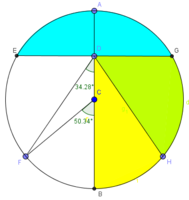Coach Sanders
New member
- Joined
- Sep 6, 2019
- Messages
- 4
Hey, I've been working on this question for years and have been unable to find anything regarding area within a circle from a point on a chord.
It involves cutting a pizza into 5 by starting with a segment equal to one fifth the area of the pizza (this is estimated since I haven't solved this problem). Then, from the midpoint of that chord, cut the remaining four fifths in half, and those 2 in half again (from that same point). The result needs to be 5 equal pieces.
The question then is: what is the height of the segment? and the measure of the angles dividing the other 4 pieces?
It involves cutting a pizza into 5 by starting with a segment equal to one fifth the area of the pizza (this is estimated since I haven't solved this problem). Then, from the midpoint of that chord, cut the remaining four fifths in half, and those 2 in half again (from that same point). The result needs to be 5 equal pieces.
The question then is: what is the height of the segment? and the measure of the angles dividing the other 4 pieces?

